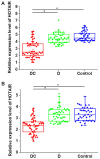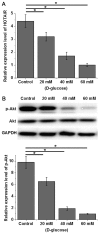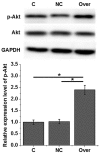LncRNA HOTAIR improves diabetic cardiomyopathy by increasing viability of cardiomyocytes through activation of the PI3K/Akt pathway
- PMID: 30542437
- PMCID: PMC6257662
- DOI: 10.3892/etm.2018.6755
LncRNA HOTAIR improves diabetic cardiomyopathy by increasing viability of cardiomyocytes through activation of the PI3K/Akt pathway
Abstract
The current study aimed to investigate the role of long non-coding RNA (lncRNA) homeobox transcript antisense RNA (HOTAIR) in the pathogenesis of diabetic cardiomyopathy. Patients with diabetic cardiomyopathy, patients with diabetes but without cardiomyopathy and healthy controls were included in the current study. All participants underwent myocardial biopsy to collect myocardial tissues. Blood samples were also collected from each participant to prepare serum. Expression of HOTAIR in myocardial tissues was detected by reverse transcription-quantitative polymerase chain reaction. Receiver operating characteristic curve analysis was performed to evaluate the diagnostic value of serum HOTAIR for diabetic cardiomyopathy. AC16 human cardiomyocyte cells were treated with high glucose to observe the changes in expression of HOTAIR and phosphorylation of Akt. HOTAIR expression vector was transfected into cells of AC16 cell line and the effects of HOTAIR overexpression on cell viability and Akt phosphorylation were detected by MTT assay and western blot analysis, respectively. HOTAIR expression was significantly downregulated in myocardial tissues and serum of patients with diabetic cardiomyopathy compared with patients with diabetes and healthy controls. Serum HOTAIR could be used to effectively distinguish patients with diabetic cardiomyopathy from healthy controls. High glucose treatment inhibited HOTAIR expression and Akt phosphorylation. HOTAIR overexpression promoted Akt phosphorylation. HOTAIR overexpression improved AC16 cell viability, while PI3K/Akt inhibitor treatment reduced this effect. LncRNA HOTAIR may improve diabetic cardiomyopathy by increasing the viability of cardiomyocytes through activation of the PI3K/Akt pathway.
Keywords: activation; diabetic cardiomyopathy; homeobox transcript antisense RNA; long non-coding RNA; phosphoinositide 3-kinase/Akt; viability.
Figures





References
-
- Alberti KG, Zimmet PZ. Definition, diagnosis and classification of diabetes mellitus and its complications. Part 1: Diagnosis and classification of diabetes mellitus. Provisional report of a WHO Consultation. Diabetic Med. 1998;15:539–553. doi: 10.1002/(SICI)1096-9136(199807)15:7<539::AID-DIA668>3.0.CO;2-S. - DOI - PubMed
-
- Imamura F, O'Connor L, Ye Z, Mursu J, Hayashino Y, Bhupathiraju SN, Forouhi NG. Consumption of sugar sweetened beverages, artificially sweetened beverages, and fruit juice and incidence of type 2 diabetes: Systematic review, meta-analysis, and estimation of population attributable fraction. BMJ. 2015;351:h3576. doi: 10.1136/bmj.h3576. - DOI - PMC - PubMed
LinkOut - more resources
Full Text Sources
Research Materials
